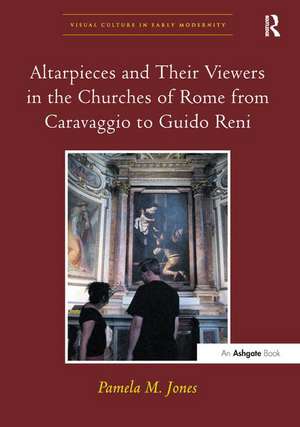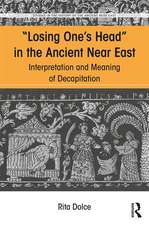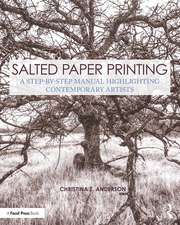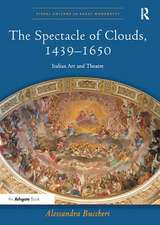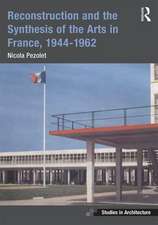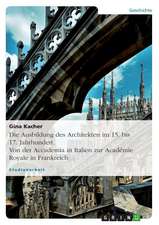Altarpieces and Their Viewers in the Churches of Rome from Caravaggio to Guido Reni: Visual Culture in Early Modernity
Autor Pamela M. Jonesen Limba Engleză Paperback – 19 oct 2016
Din seria Visual Culture in Early Modernity
- 26%
 Preț: 324.16 lei
Preț: 324.16 lei - 23%
 Preț: 1055.95 lei
Preț: 1055.95 lei -
 Preț: 311.37 lei
Preț: 311.37 lei - 9%
 Preț: 1022.27 lei
Preț: 1022.27 lei -
 Preț: 312.12 lei
Preț: 312.12 lei -
 Preț: 356.70 lei
Preț: 356.70 lei -
 Preț: 336.27 lei
Preț: 336.27 lei -
 Preț: 432.98 lei
Preț: 432.98 lei - 17%
 Preț: 343.55 lei
Preț: 343.55 lei - 25%
 Preț: 324.16 lei
Preț: 324.16 lei - 30%
 Preț: 769.92 lei
Preț: 769.92 lei - 17%
 Preț: 338.33 lei
Preț: 338.33 lei - 22%
 Preț: 259.98 lei
Preț: 259.98 lei - 25%
 Preț: 326.11 lei
Preț: 326.11 lei -
 Preț: 471.08 lei
Preț: 471.08 lei - 28%
 Preț: 826.84 lei
Preț: 826.84 lei - 28%
 Preț: 819.90 lei
Preț: 819.90 lei - 28%
 Preț: 878.42 lei
Preț: 878.42 lei - 28%
 Preț: 829.69 lei
Preț: 829.69 lei - 30%
 Preț: 853.03 lei
Preț: 853.03 lei - 17%
 Preț: 339.96 lei
Preț: 339.96 lei - 30%
 Preț: 830.92 lei
Preț: 830.92 lei - 16%
 Preț: 338.33 lei
Preț: 338.33 lei - 30%
 Preț: 826.02 lei
Preț: 826.02 lei - 30%
 Preț: 772.60 lei
Preț: 772.60 lei - 18%
 Preț: 1017.63 lei
Preț: 1017.63 lei - 30%
 Preț: 768.62 lei
Preț: 768.62 lei - 17%
 Preț: 338.33 lei
Preț: 338.33 lei - 30%
 Preț: 771.07 lei
Preț: 771.07 lei - 26%
 Preț: 324.84 lei
Preț: 324.84 lei - 30%
 Preț: 772.76 lei
Preț: 772.76 lei - 16%
 Preț: 347.33 lei
Preț: 347.33 lei - 31%
 Preț: 765.03 lei
Preț: 765.03 lei -
 Preț: 489.26 lei
Preț: 489.26 lei - 28%
 Preț: 822.91 lei
Preț: 822.91 lei - 18%
 Preț: 300.09 lei
Preț: 300.09 lei - 28%
 Preț: 820.73 lei
Preț: 820.73 lei - 28%
 Preț: 829.69 lei
Preț: 829.69 lei - 28%
 Preț: 826.84 lei
Preț: 826.84 lei - 30%
 Preț: 776.03 lei
Preț: 776.03 lei
Preț: 325.43 lei
Preț vechi: 432.72 lei
-25% Nou
Puncte Express: 488
Preț estimativ în valută:
62.28€ • 67.63$ • 52.31£
62.28€ • 67.63$ • 52.31£
Carte tipărită la comandă
Livrare economică 22 aprilie-06 mai
Preluare comenzi: 021 569.72.76
Specificații
ISBN-13: 9781138246737
ISBN-10: 1138246735
Pagini: 390
Dimensiuni: 174 x 246 x 27 mm
Greutate: 0.52 kg
Ediția:1
Editura: Taylor & Francis
Colecția Routledge
Seria Visual Culture in Early Modernity
Locul publicării:Oxford, United Kingdom
ISBN-10: 1138246735
Pagini: 390
Dimensiuni: 174 x 246 x 27 mm
Greutate: 0.52 kg
Ediția:1
Editura: Taylor & Francis
Colecția Routledge
Seria Visual Culture in Early Modernity
Locul publicării:Oxford, United Kingdom
Cuprins
Contents: Introduction; The triumph of chastity and justice in Christian Rome: Tommaso Laureti's Martyrdom of Saint Susanna (ca 1595-97) in the church of S. Susanna; The place of poverty in Seicento Rome: bare feet, humility, and the pilgrimage of life in Caravaggio's Madonna of Loreto (ca 1605-06) in the church of S. Agostino; Serving the poor sick with humility from the lazzaretto of Milan to the hospitals of Rome: Andrea Commodi's S. Carlo Borromeo Venerating the Holy Nail (ca 1621-22) in the church of S. Carlo ai Catinari; From sin to salvation: Guercino's Penitent Magdalene (ca 1622) for the church of S. Maria Maddalena delle Convertite al Corso and the fight against prostitution; Leading pilgrims to paradise: Guido Reni's Holy Trinity (1625-26) in the church of SS. Trinità dei Pellegrini e Convalescenti and the care of bodies and souls; Conclusion; Bibliography; Index.
Notă biografică
Pamela M. Jones is Professor of Art History at the University of Massachusetts Boston, USA. She is the author of Federico Borromeo and the Ambrosiana and a co-curator of the exhibition Hope and Healing: Painting in Italy in a Time of Plague.
Recenzii
Winner, CAA Millard Meiss Publication Fund Grant
'Richly documented, subtly conceived, and lucidly argued, Pamela M. Jones’s important new book reconstructs the viewing audiences of five major reform altarpieces commissioned between 1595 and 1625. Her efforts to embed the act of beholding within various registers of cultural experience and socioeconomic horizons of expectation, result in compelling analyses of the altarpieces, which are seen to enliven, indeed, to instrumentalize the full spectrum of religious life.' Walter Melion, Asa Griggs Candler Professor of Art History, Emory University, USA
'... exhaustively researched... Jones's use of a wide variety of sources provides fascinating and corrective insights into the religious realities of the period... Jones's book is a valuable addition to the social history of art...’ The Burlington Magazine
'This is a thought-provoking, stimulating and handsomely-presented book, taking the reader into fascinating fresh paths of inquiry, where Jones will doubtless be followed by many other researchers.’ Renaissance Quarterly
'In the five case studies that comprise this excellent book, Pamela M. Jones eschews grand theories and epistemological pyrotechnics in favor of painstaking research and judicious argument. ... Such genuine interdisciplinarity, and the lightness with which Jones wears her learning, make this book important and stimulating reading for specialists, and for any scholar concerned with the relationship of art and society in the early modern period.’ American Historical Review
'In this masterfully documented and sensitively narrated study of five early seicento Roman altarpieces, Pamela Jones has once again demonstrated her broad knowledge and comprehension of the religious culture of early modern Italy... In this book Pamela Jones has presented an exceptionally effective example of how cultural historians should be able to achieve an extremely difficult goal - the assessment of viewers' reception of, appreciation for, and use of religious imagery for contemplative purposes - by examining a far wider range of sources than simply the images and the literature written about them by contemporary conoscenti. It stands as a model for future studies of this scope, be they focused on Counter-Reformation Italy or any other period of religious art and architecture.' Church History
'Richly documented, subtly conceived, and lucidly argued, Pamela M. Jones’s important new book reconstructs the viewing audiences of five major reform altarpieces commissioned between 1595 and 1625. Her efforts to embed the act of beholding within various registers of cultural experience and socioeconomic horizons of expectation, result in compelling analyses of the altarpieces, which are seen to enliven, indeed, to instrumentalize the full spectrum of religious life.' Walter Melion, Asa Griggs Candler Professor of Art History, Emory University, USA
'... exhaustively researched... Jones's use of a wide variety of sources provides fascinating and corrective insights into the religious realities of the period... Jones's book is a valuable addition to the social history of art...’ The Burlington Magazine
'This is a thought-provoking, stimulating and handsomely-presented book, taking the reader into fascinating fresh paths of inquiry, where Jones will doubtless be followed by many other researchers.’ Renaissance Quarterly
'In the five case studies that comprise this excellent book, Pamela M. Jones eschews grand theories and epistemological pyrotechnics in favor of painstaking research and judicious argument. ... Such genuine interdisciplinarity, and the lightness with which Jones wears her learning, make this book important and stimulating reading for specialists, and for any scholar concerned with the relationship of art and society in the early modern period.’ American Historical Review
'In this masterfully documented and sensitively narrated study of five early seicento Roman altarpieces, Pamela Jones has once again demonstrated her broad knowledge and comprehension of the religious culture of early modern Italy... In this book Pamela Jones has presented an exceptionally effective example of how cultural historians should be able to achieve an extremely difficult goal - the assessment of viewers' reception of, appreciation for, and use of religious imagery for contemplative purposes - by examining a far wider range of sources than simply the images and the literature written about them by contemporary conoscenti. It stands as a model for future studies of this scope, be they focused on Counter-Reformation Italy or any other period of religious art and architecture.' Church History
Descriere
A social history of reception, this study focuses on art and Catholicism in early modern Rome. The five public altarpieces examined here-by Caravaggio, Guercino, Guido Reni, Tommaso Laureti, and Andrea Commodi-are seen anew through the eyes of female and male viewers from all walks of life. In treating officially sanctioned and unorthodox responses, Jones illuminates problems churchmen faced when trying to channel the power of images to reform Catholic society.
